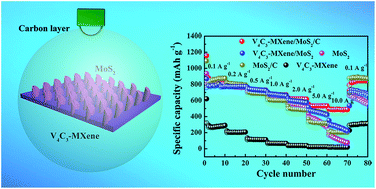Construction of hierarchical V4C3-MXene/MoS2/C nanohybrids for high rate lithium-ion batteries†
Abstract
MoS2 is a promising anode candidate for high-performance lithium-ion batteries (LIBs) due to its unique layered structure and high specific capacity. However, the poor conductivity and unsatisfactory structural stability limit its practical application. Recently, a new class of 2D materials, V4C3-Mxene, has been found to combine metallic conductivity, high structural stability and rich surface chemistries. Herein, a facile method has been developed to fabricate V4C3-MXene/MoS2/C nanohybrids. Ultrasmall and few-layered MoS2 nanosheets are uniformly anchored on the surface of V4C3-MXene with a thin carbon-coating layer. The ultrasmall and few-layered MoS2 nanosheets can enlarge the specific areas, reduce the diffusion distance of lithium ions, and accelerate the transfer of charge carriers. As a supporting substrate, V4C3-MXene endows the nanohybrid with high electrical conductivity, strong structural stability, and fast reaction kinetics. Moreover, the carbon-coating layer can further enhance the electrical conductivity and structural stability of the hybrid material. Benefiting from these advantages, the V4C3-MXene/MoS2/C electrode shows an excellent cycling stability with a high reversible capability of 622.6 mA h g−1 at 1 A g−1 after 450 cycles, and a superior rate capability of 500.0 mA h g−1 at 10 A g−1. Thus, the V4C3-MXene/MoS2/C nanohybrid could become a promising anode material for high rate LIBs.



 Please wait while we load your content...
Please wait while we load your content...